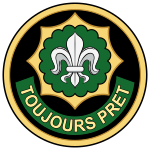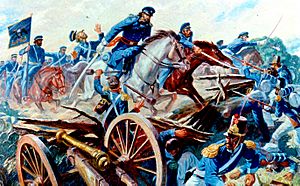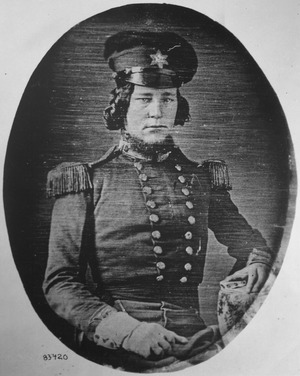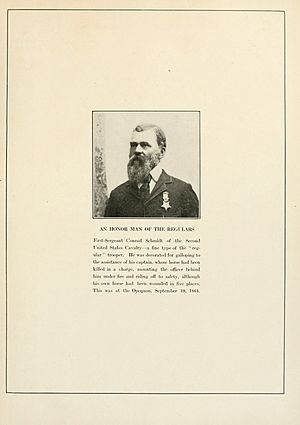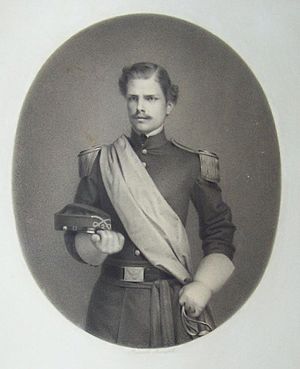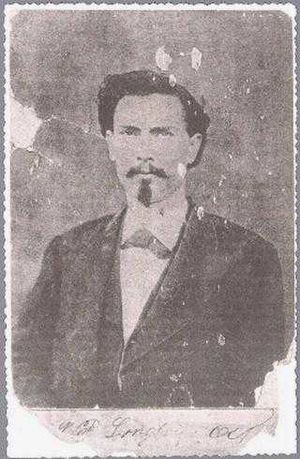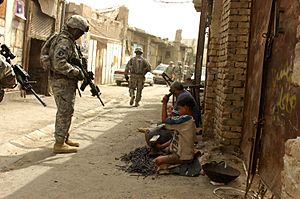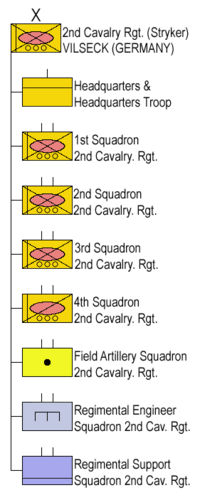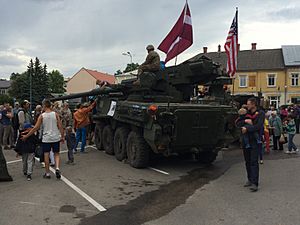2nd Cavalry Regiment (United States) facts for kids
Quick facts for kids 2nd Cavalry Regiment(2nd Dragoons) |
|
|---|---|

Regimental coat of arms
|
|
| Active | 1836–present |
| Country | |
| Branch | |
| Type | Cavalry |
| Role | Mechanized Infantry |
| Part of | USAREUR-AF |
| Garrison/HQ | Rose Barracks, Vilseck, Germany |
| Nickname(s) | Second Dragoons |
| Motto(s) | Toujours Prêt (Always Ready) |
| Engagements | Mexican–American War Indian Wars American Civil War Spanish–American War Philippine–American War World War I World War II Gulf War * Battle of 73 Easting Bosnia War on Terror |
| Commanders | |
| Commander | Colonel Robert McChrystal |
| Command Sgt Major | CSM Benjamin E Pingel |
| Notable commanders |
William S. Harney Henry Hopkins Sibley David E. Twiggs John T. Cole Albert Sidney Johnston Philip St. George Cooke Joseph T. Dickman Harry Chamberlin Creighton Abrams< David M. Maddox John H. Tilelli, Jr. Don Holder Walter L. Sharp |
| Insignia | |
| Regimental distinctive insignia | |
| Shoulder sleeve insignia | |
The 2nd Cavalry Regiment, also known as the 2nd Dragoons, is an active Stryker infantry and cavalry regiment of the United States Army. It is part of the United States Army Europe and Africa and is based in Vilseck, Germany. This regiment has a long history, dating back to the early 1800s.
Over the years, the 2nd Cavalry Regiment has been known by several names. These include the 2nd Riflemen, 2nd Dragoons, 2nd Constabulary Regiment, 2nd Armored Cavalry, and 2nd Stryker Cavalry.
Contents
- What Were the Regiment's Past Names?
- What is the Motto and Symbolism?
- A Brief History of the 2nd Cavalry Regiment
- Early Years (1808-1846)
- Fighting in the Mexican-American War (1846-1848)
- Protecting the Frontier (1848-1861)
- The American Civil War (1861-1865)
- Indian Wars (1865-1890)
- Spanish-American War (1898)
- Philippines and Mexican Border (1905-1914)
- World War I (1917-1919)
- World War II (1939-1945)
- Cold War (1945-1990)
- Operation Desert Storm (1990-1991)
- Peacekeeping in Haiti (1995-1996)
- Service in Bosnia (1997-1998)
- War on Terror (2001-Present)
- How is the Regiment Organized Today?
- Who Received the Medal of Honor?
- Notable People Who Served in the Regiment
- Regimental Commanders
- Alliances with Other Countries
- See also
What Were the Regiment's Past Names?
The 2nd Cavalry Regiment has changed its name several times throughout its history:
- 2nd Regiment of Dragoons (May 1836 – March 1843, April 1844 – August 1861)
- 2nd Regiment of Riflemen (March 1843 – April 1844)
- 2nd US Cavalry Regiment (August 1861 – July 1942)
- 2nd Cavalry Regiment (Mechanized) (January 1943 – December 1943)
- 2nd Cavalry Group (Mechanized) (December 1943 – July 1946)
- 2nd Constabulary Regiment (July 1946 – November 1948)
- 2nd Armored Cavalry Regiment (November 1948 – July 1992)
- 2nd Armored Cavalry Regiment (Light) (July 1992 – March 2005)
- 2nd Cavalry Regiment (March 2005 – June 2006)
- 2nd Stryker Cavalry Regiment (June 2006 – July 2011)
- 2nd Cavalry Regiment (July 2011 – present)
What is the Motto and Symbolism?

The motto of the 2nd Cavalry Regiment is Toujours Prêt, which means "Always Ready" in French. This motto shows the spirit of the regiment.
What Does the Coat of Arms Mean?
The coat of arms for the 2nd Cavalry Regiment was first approved in 1920.
- Shield: It shows a dragoon (a soldier who fights on horseback) from the Mexican War. He is on a white horse, holding a saber, and charging a Mexican cannon. This represents a famous charge by Captain May's squadron during the Battle of Resaca de la Palma.
- Colors: The orange color on the shield was the color of the old dragoon regiment's uniforms.
- Stars: The two eight-pointed stars represent the regiment's number, "2nd."
What Does the Distinctive Unit Insignia Mean?
The distinctive unit insignia is a metal and enamel badge.
- Star: It features an eight-pointed gold star, like the ones worn by dragoons.
- Palmetto Leaf: A green palmetto leaf is on the star. This represents the regiment's first battle against the Seminole Indians in Florida, where these leaves are common.
- Fleur-de-lis: A silver fleur-de-lis (a lily-shaped symbol) is included. This stands for the regiment's service in France during both World War I and World War II.
- Motto: The motto "Toujours Prêt" (Always Ready) is on a green ribbon at the bottom.
A Brief History of the 2nd Cavalry Regiment
The 2nd Cavalry Regiment has a long and important history, fighting in many major conflicts.
Early Years (1808-1846)
The regiment's roots go back to 1808 with light dragoon units. During the War of 1812, these units fought in battles like Lundy's Lane. The 2nd Regiment of Dragoons was officially created by President Andrew Jackson on May 23, 1836. Soldiers were recruited from various states. In 1837, the main base moved to Jefferson Barracks, Missouri. Here, new recruits learned how to be dragoons.
First Combat: Second Seminole War
The 2nd Dragoons first saw combat in the Second Seminole War in Florida. One company had its first fight on June 10, 1836. In January 1837, they fought the Seminoles at Fort Mellon. They were known for actively seeking out the enemy instead of waiting to be attacked.
Fighting in the Mexican-American War (1846-1848)
In 1845, the 2nd Dragoons marched to Corpus Christi, Texas. They patrolled the Rio Grande river. On April 25, 1846, Mexican troops ambushed two companies of the 2nd Dragoons. This event, called the Thornton Affair, led to the Mexican–American War.
During the Battle of Palo Alto, the 2nd Dragoons helped push back the enemy. The next day, at the Battle of Resaca de la Palma, Captain Charles A. May's companies were ordered to attack Mexican cannons. His simple order, "Remember your Regiment and follow your officers," became the regiment's motto. They destroyed the cannons and captured a Mexican general.
The 2nd Dragoons fought in nearly every major battle of the war. Their bravery was shown by soldiers like Sergeant Jack Miller. In November 1847, his small patrol of 20 dragoons was ambushed by 100 Mexicans. He ordered his men to charge with sabers, and they defeated the larger force.
Protecting the Frontier (1848-1861)
After the Mexican-American War, the 2nd Dragoons moved west. Their job was to protect settlers moving into new territories. In 1849, F Company helped establish Fort Worth. They patrolled against hostile Native American tribes.
In 1854, companies from the regiment defeated a large Sioux force in the Battle of Ash Hollow in Nebraska. This led to a peace treaty. Later, in 1857, a group of 2nd Dragoons was sent to Utah to deal with conflicts involving Mormon settlers. Peace talks resolved the issue, but the dragoons faced a difficult winter march.
In 1858, other parts of the 2nd Dragoons fought the Comanche in Texas. In the Battle of the Wichita Village, they helped fight off about 500 Comanches, rescuing a captured child.
The American Civil War (1861-1865)
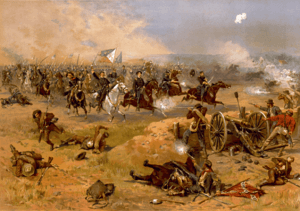
When the American Civil War began in 1861, the regiment was renamed the Second Cavalry Regiment. They fought in many important battles, including the Second Battle of Bull Run, Battle of Antietam, and Battle of Gettysburg.
During the Battle of Fredericksburg in 1862, Sergeant Martin Hagan and a small group held off a Confederate cavalry brigade. This allowed Union troops to retreat safely. Sergeant Hagan received the regiment's first Medal of Honor.
At the Battle of Kelly's Ford, the 2nd Cavalry was the first Union cavalry unit to directly charge Confederate General J.E.B. Stuart's cavalry. This was a significant moment for the Union cavalry.
In the Battle of Trevilian Station in 1864, Captain T.F. Rodenbough led a charge and earned the Medal of Honor. Later, during the Third Battle of Winchester, First Sergeant Conrad Schmidt rescued his wounded commander under fire, also earning the Medal of Honor. Private Edward Hanson earned the Medal of Honor for capturing a Confederate flag. The 2nd Cavalry earned 14 battle streamers and 5 Medals of Honor during the Civil War.
Indian Wars (1865-1890)
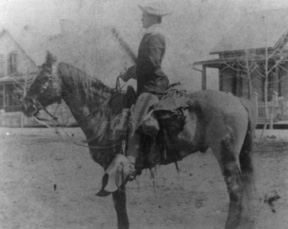
After the Civil War, the 2nd Cavalry Regiment moved west again. Their mission was to fight hostile Native American tribes and protect settlers. The regiment was often spread out across the vast frontier.
In 1866, 25 troopers of the 2nd Cavalry were killed in the Fetterman Fight in Wyoming, battling about 1,000 Native Americans. In 1867, a small party of 12 cavalrymen and a scout were killed in the Kidder fight in Kansas.
On January 23, 1870, parts of the regiment took part in the Marias Massacre in Montana. After this, U.S. policy shifted towards more peaceful solutions. On May 15, 1870, Sergeant Patrick James Leonard and four other troopers fought off 50 Native Americans in Nebraska. All five men received the Medal of Honor for their bravery.
In 1876, the 2nd Cavalry fought in the Battle of Powder River and the Battle of the Rosebud against the Cheyenne and Lakota. They were repulsed in both battles. Later, on May 7, 1878, the "Montana Battalion" of the 2nd Cavalry surprised and defeated Chief Lame Deer's warriors at Little Muddy Creek, Montana. Private William Leonard and Private Samuel D. Phillips earned the Medal of Honor in this battle.
In 1877, elements of the 2nd Cavalry pursued Chief Joseph's Nez Perce Indians. Corporal Harry Garland and three other men earned the Medal of Honor for their actions in battles like Camas Meadows. On September 30, 1877, the Battle of Bear Paw Mountain began, where the 2nd Cavalry helped capture Chief White Bird's band. Lieutenant Edward John McClernand received the Medal of Honor. Chief Joseph surrendered shortly after.
In 1879, Sergeant T.B. Glover earned the Medal of Honor for capturing Sioux war parties. In 1880, Captain Eli L. Huggins and Second Lieutenant Lloyd M. Brett earned the Medal of Honor at O'Fallon's Creek, Montana, for their leadership in a battle against Sioux. During the Indian Wars, the 2nd Cavalry earned 13 battle streamers and 15 Medals of Honor.
Spanish-American War (1898)
When the Spanish–American War started, the 2nd Cavalry Regiment gathered in Georgia. Four of their troops sailed to Cuba. They were the only horse-mounted cavalry units there. They fought alongside Theodore Roosevelt's Rough Riders in battles like El Caney and San Juan Hill. After the fighting, they helped with public education and sanitation in Cuba for three years.
Philippines and Mexican Border (1905-1914)
The 2nd Cavalry Regiment was sent to the Philippines to fight in the Philippine Insurrection. They participated in the Cavite Campaign in 1905 and fought in battles on Mindanao and Jolo islands in 1911-1912.
After returning to the U.S. in 1912, they were sent to the Mexican border. Their job was to enforce laws and prevent raids by bandits. They patrolled a long stretch of the border from El Paso to Presidio, Texas.
World War I (1917-1919)
When the U.S. entered World War I in 1917, the 2nd Cavalry Regiment was split. Parts of it formed the 18th and 19th Cavalry Regiments, which later became artillery units. Thirty-one troopers from the 2nd Cavalry Headquarters Troop were the first American troops to land in Europe. They served as an escort for General John J. Pershing. The rest of the regiment arrived in France in April 1918. They helped manage horse depots and served as military police.
The 2nd Cavalry fought in the Aisne-Marne Offensive and the Oise-Aisne Offensive. They also fought bravely in the Battle of Saint-Mihiel, scouting ahead for the advancing American forces.
Their largest battle in World War I was the Meuse-Argonne Offensive. They served as the left flank of the advance, fighting for six days. The regiment was praised for its "fearlessness, courage, and disregard for danger." By the end of the war, they had earned three more campaign streamers. They remained in Germany as part of the occupation force until 1919.
World War II (1939-1945)
Before World War II, the 2nd Cavalry was based at Fort Riley, Kansas. They trained other cavalry units. In 1936, they received their first armored cars. On July 15, 1942, the 2nd Cavalry Regiment was temporarily deactivated. Its troops and equipment were transferred to the new 2nd Armored Regiment. It was reactivated on January 15, 1943, as the 2nd Mechanized Cavalry Group (MCG).
In July 1944, the 2nd MCG landed in Normandy as part of General George S. Patton's Third Army. They provided security and reconnaissance. German soldiers called them "Ghosts of Patton's Army" because of their daring missions. The 2nd MCG protected the army's flanks and supply lines. They fought against German units, including a counterattack by Panther tanks. This showed how effective Mechanized Cavalry Groups were in World War II.
In October, they helped the 26th Infantry Division by capturing Moncourt Ridge. This showed their flexibility, as they fought dismounted like dragoons. In December 1944, they helped relieve Bastogne during the Battle of the Bulge.
One of their most famous missions was at the end of the war. On April 28, 1945, A Troop, 42nd Squadron, captured the town of Hostouň in Czechoslovakia. They liberated Allied prisoners of war and found 670 horses, including the famous Lipizzaner stallions. General Patton ordered their rescue. On May 12, "Operation Cowboy" successfully rescued the horses. This event was even made into a Walt Disney movie called Miracle of the White Stallions.
Cold War (1945-1990)
During the Cold War, the 2nd Cavalry was responsible for patrolling the Iron Curtain border in Germany. They were based in Germany for 33 years, from 1958 to 1991. They guarded 731 kilometers of the border between West Germany and East Germany/Czechoslovakia. In 1989, the Iron Curtain fell, and their border security missions ended in March 1990.
Operation Desert Storm (1990-1991)
When the Gulf War began in 1990, the regiment moved to Saudi Arabia. They formed the "Dragoon Battle Group" with 8,500 soldiers. On February 23, 1991, the 2nd Cavalry attacked across the Saudi–Iraq border. They led the advance into southern Iraq. In the Battle of 73 Easting, the 2nd and 3rd Squadrons destroyed two brigades of the Iraqi Republican Guards. The 2nd Squadron alone destroyed 55 Iraqi tanks.
By the end of their mission, the 2nd ACR had broken the Republican Guard's defenses. They captured 2,000 prisoners and destroyed many enemy vehicles. The regiment earned the Valorous Unit Award. They lost 6 Dragoons killed and 19 wounded.
Peacekeeping in Haiti (1995-1996)
After the Gulf War, the 2nd Armored Cavalry Regiment was reactivated as a "Light" unit. They were equipped with Humvees. From 1995 to 1996, they deployed to Haiti for Operation Uphold Democracy, a peacekeeping mission. They guarded aid convoys, seized illegal weapons, and conducted security patrols. They also protected the Haitian and U.S. Presidents during visits.
Service in Bosnia (1997-1998)
In April 1997, the regiment was sent to Bosnia and Herzegovina for Operation Joint Guard. They helped with municipal elections and took control of Serbian radio-television towers to manage communications. They also helped restructure the local police and create the first multi-ethnic police department in Brčko. The regiment oversaw the removal of over 12,000 mines and inspected many weapon storage sites. They served one of the longest tours of any military unit there.
War on Terror (2001-Present)
Iraq War (2003-2008)
On April 5, 2003, the 2nd Squadron deployed to Iraq for Operation Iraqi Freedom. The rest of the regiment arrived in May. They worked to improve daily life for people, securing power stations, schools, and hospitals. They also conducted raids against the Fedayeen Saddam militia.
On August 19, 2003, a car bomb exploded near a UN building. The 2nd Cavalry quickly secured the area and saved 125 UN workers. In April 2004, the 2nd Armored Cavalry fought in the Siege of Sadr City. They clashed with thousands of Muqtada al-Sadr's militiamen, the Mahdi Army. This intense battle resulted in 8 U.S. and 300 enemy deaths. They then fought insurgents in other cities like Hillah and An Najaf.
After 16 months in combat, the Dragoons returned to the U.S. They had 21 killed and over 100 wounded. They inflicted 1,000 enemy deaths and captured hundreds more. They earned another Presidential Unit Citation. In 2005, the regiment was reorganized as a Stryker brigade combat team.
In 2007, the Dragoons returned to Iraq as part of President George W. Bush's surge campaign. They worked in Baghdad, fighting insurgents and building security walls. They partnered with the Iraqi Army and Iraqi Police. In April 2008, the 2nd Cavalry Regiment moved to Diyala Governorate. They worked with Iraqi allies to clear out terrorist strongholds and conduct humanitarian operations. After a 15-month tour, they returned to Germany in November 2008. During this tour, 29 troopers were killed and 250 wounded. They captured or destroyed 100,000 enemy items.
Afghanistan War (2010-2014)
On March 15, 2010, the 2nd Cavalry Regiment was sent to Afghanistan for Operation Enduring Freedom. They arrived in July 2010. 1st Squadron took responsibility for Tarin Kowt. The rest of the regiment was in Kandahar Province. 3rd Squadron participated in Operation Dragon Strike, earning a Presidential Unit Citation for their intense fighting and efforts to stabilize the region.
In the summer of 2013, the 2nd Cavalry Regiment deployed to Afghanistan for a second time. They returned to Germany in April 2014. The regiment received the Meritorious Unit Citation for their work in Kandahar Province.
How is the Regiment Organized Today?
The 2nd Cavalry Regiment is organized as a Stryker brigade combat team. This means they use Stryker vehicles, which are armored vehicles that can move quickly. The regiment includes:
- Regimental Headquarters and Headquarters Troop ("Vipers")
- Four cavalry squadrons:
- 1st Squadron ("War Eagles")
- 2nd Squadron ("Cougars")
- 3rd Squadron ("Wolfpack")
- 4th Squadron ("Saber") - This squadron focuses on reconnaissance (scouting), surveillance, and target acquisition.
- Regimental Engineer Squadron ("Pioneers") - This squadron handles engineering tasks.
- Field Artillery Squadron ("Artillery Hell") - This squadron provides artillery support.
- Regimental Support Squadron ("Muleskinners") - This squadron provides supplies, maintenance, and medical support.
Who Received the Medal of Honor?
The Medal of Honor is the highest military award for bravery. Many members of the 2nd Cavalry Regiment have received it:
- Sergeant Conrad Schmidt (Civil War)
- Private Heth Canfield (Indian Wars)
- Private Michael Himmelsback (Indian Wars)
- Private Patrick James Leonard (Indian Wars)
- Private Thomas Hubbard (Indian Wars)
- Private George W. Thompson (Indian Wars)
- Private Wilfred Clark (Indian Wars)
- Private William Leonard (Indian Wars)
- First Sergeant Henry Wilkens (Indian Wars)
- Private Samuel D. Phillips (Indian Wars)
- Corporal Harry Garland (Indian Wars)
- William H. Jones (Indian Wars)
- Second Lieutenant Edward J. McClernand (Indian Wars)
- Sergeant T.B. Glover (Indian Wars)
- Captain Eli L. Huggins (Indian Wars)
- Second Lieutenant Lloyd M. Brett (Indian Wars)
Notable People Who Served in the Regiment
Many important military leaders and public figures have served in the 2nd Cavalry Regiment, including:
- John Buford
- George Armstrong Custer
- Creighton W. Abrams
- Tommy Franks
- H. R. McMaster
- Peter Schoomaker
- Martin Dempsey
- Mike Pompeo
Regimental Commanders
Some of the commanders of the 2nd Cavalry Regiment include:
- David E. Twiggs
- William S. Harney
- Philip St. George Cooke
- Joseph T. Dickman
- John T. Cole
- Colonel Leonard D. "Don" Holder
Alliances with Other Countries
The 2nd Cavalry Regiment has bonds of friendship with military units from other countries:
 Australia – 2nd Cavalry Regiment
Australia – 2nd Cavalry Regiment Germany – German Logistikbataillon 4
Germany – German Logistikbataillon 4
See also
 In Spanish: 2.º Regimiento de Caballería (Estados Unidos) para niños
In Spanish: 2.º Regimiento de Caballería (Estados Unidos) para niños



